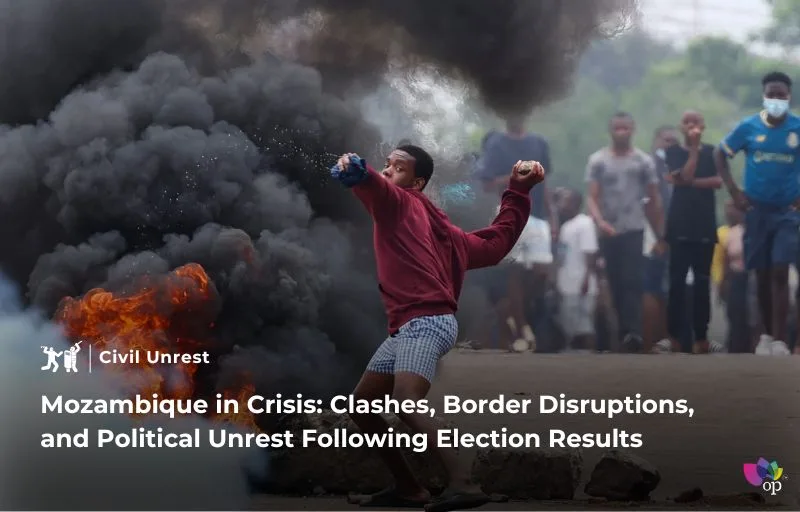Introduction: In Mozambique, political unrest has escalated in the wake of the controversial October 9 presidential election. Despite opposition claims of fraud and election irregularities, the country’s Constitutional Court confirmed Daniel Chapo of the ruling Frelimo party as the winner, securing 65.17% of the vote. The aftermath has been marked by violent protests, mass casualties, widespread civil unrest, and significant disruptions at key border points, particularly the Lebombo border post.
Violence and Casualties: Since the court’s confirmation of Chapo’s victory on December 23, protests have erupted across major cities, particularly around the capital, Maputo, and in northern provinces like Nampula and the second-largest city, Beira. The violence quickly escalated, with protesters clashing with police and security forces, leading to the destruction of property, including buildings and supermarkets. In the first 24 hours of unrest, authorities reported 21 deaths. However, as the situation worsened, a non-governmental organization, Plataforma Decide, reported that the total death toll had climbed to 125 by Thursday, December 26. This marked a grim milestone in what has been a long-standing political crisis.
One of the most alarming developments was a mass jailbreak near Maputo, where at least 33 prisoners were killed in violent clashes as they attempted to escape during the riots. Since the unrest began in October, more than 4,000 people have been arrested, with 137 arrests occurring within the past few days alone.
Opposition Claims and Government Response: Exiled opposition leader Venancio Mondlane has been at the forefront of accusations against the government, claiming the election was rigged and that security forces were orchestrating violence and looting to justify declaring a state of emergency. Mondlane argues that the chaos is being used to suppress the protests and strengthen the ruling party’s grip on power.
Despite these claims, the government of President Chapo has insisted on the legitimacy of the election results, backed by the Constitutional Court’s decision. The protests, however, continue to gain momentum as many citizens remain skeptical of the election process and its outcome.
Impact on Mozambique’s Border and South Africa: The unrest has not only affected domestic politics but has also caused significant disruptions to regional trade. The Lebombo border post, a key crossing point between Mozambique and South Africa, has been hit particularly hard by the violence. The post, which processes thousands of trucks daily, has been closed to cargo traffic due to protests targeting vehicles on the Mozambican side of the border.
In addition to the suspension of cargo processing, extensive queues of trucks have formed on the South African side, with delays estimated at several days. This disruption comes on the heels of a $5 billion loss in the previous month, caused by similar delays due to the ongoing insecurity along the N4 corridor leading to the Maputo port. Public transport between the two countries has also been significantly affected, further straining the movement of goods and people during the busy festive season.
South African authorities have made efforts to maintain operations at the border, with Border Management Authority Commissioner Michael Masiapato assuring the public that over 26,000 individuals were processed on December 22, despite the chaos. However, the closure of the Lebombo post for trucks has caused significant challenges for the transport and logistics sectors.
Air Travel Disruptions: The ongoing unrest has also impacted air travel. South African airline Airlink announced the cancellation of flights between Maputo and Cape Town as well as Johannesburg due to the unsafe conditions in and around the Maputo airport. Other flights to Mozambique’s regional airports, including Beira, Nampula, and Vilanculos, have continued as scheduled.
Airlink officials stated that they are closely monitoring the situation and will resume normal services once the conditions around Maputo airport stabilize. The uncertainty surrounding air travel reflects the broader instability in the country, making it difficult for both businesses and tourists to navigate.
Broader Implications: The situation in Mozambique highlights a deeper crisis within the country, where the ruling Frelimo party has maintained a stronghold on power since 1975. While the official election results have been upheld, the widespread protests and the growing number of casualties signal a deepening political divide, with many questioning the legitimacy of the process.
Additionally, the violence and disruptions have not only affected the political landscape but also the economy, particularly trade relations with neighboring South Africa. The closure of border posts and disruption of key transport corridors underscore the delicate balance between political stability and economic well-being in Southern Africa.
Conclusion: Mozambique finds itself at a crossroads. The combination of violent protests, political unrest, and significant disruptions to daily life has created a volatile environment in the country. With at least 125 people dead and many more injured, the crisis is far from over. As tensions continue to rise, the international community must closely monitor developments, and Mozambique’s leadership must find ways to address the root causes of this unrest and restore peace and stability to the region.
Analysis: The current crisis in Mozambique serves as a stark reminder of the challenges many African nations face in ensuring the credibility of their electoral processes. As political parties struggle for control, the country’s citizens bear the brunt of the violence and instability. The involvement of security forces in the suppression of protests and the targeting of infrastructure further exacerbates the situation. As Mozambique seeks a path forward, it will need to balance the demands of political reform with the urgent need for peace and stability to avoid further economic fallout and a potential collapse in governance.
References


